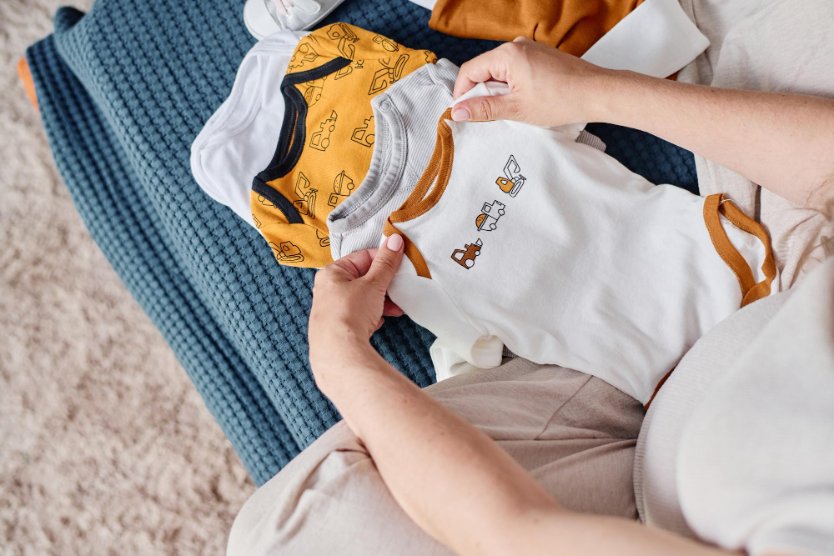Expert advice on sizing, safety, and sustainable choices for 2025
Table of Contents
- Understanding Newborn & Infant Clothing Sizes
- Essential Baby Clothes for New Parents
- What Baby Clothes You Need for the First Year
- Clothing Materials and Baby’s Comfort
- Sustainable & Organic Baby Clothing Trends 2025
- Styling Newborns: Tips and Trends
- Safety and Practicality in Infant Wear
- What Should a Baby Wear to Sleep
- Dressing Baby for Special Occasions
- Shopping for Baby Clothes on a Budget
- Gift-Giving Guide for Newborn Clothing
- Baby Clothing Care and Maintenance
- Frequently Asked Questions
Dressing a newborn can feel overwhelming with all the tiny clothes and endless options available. Choosing the right baby clothes means focusing on comfort, safety, and practicality while keeping your little one cozy through every stage of growth.
You can find quality baby clothing at many retailers, from budget-friendly options to specialty boutiques. The best baby clothes feature soft materials, simple closures, and room for growth. Many brands offer seasonal options and accessories to keep babies comfortable year-round.
Key Takeaways
- Soft, stretchy fabrics and easy-access closures make dressing babies simpler and more comfortable
- Basic pieces like bodysuits and mix-and-match sets form the foundation of a practical baby wardrobe
- Smart shopping across different retailers helps parents build a complete wardrobe while staying within budget
- Sustainable and organic options are becoming the gold standard for conscious parents
Understanding Newborn & Infant Clothing Sizes
Baby clothes sizes can be tricky to navigate. Most brands follow age-based sizing, but babies grow at different rates.
Newborn (NB) sizes fit babies up to 1 month old. These outfits work best for infants between 5-8 pounds. The next size up is 0-3 months, which fits babies weighing 8-12 pounds. Babies typically wear this size from birth to about 3 months old.
| Size Label | Weight Range | Length Range | Typical Age |
|---|---|---|---|
| Preemie | Under 5 lbs | Under 17″ | Premature babies |
| Newborn (NB) | 5-8 lbs | 18-21″ | 0-1 month |
| 0-3 Months | 8-12 lbs | 21-24″ | 0-3 months |
| 3-6 Months | 12-16 lbs | 24-26″ | 3-6 months |
| 6-9 Months | 16-20 lbs | 26-28″ | 6-9 months |
Should I Buy 0000 or 000 for a Newborn?
The choice between 0000 and 000 depends on your baby’s expected birth weight. 0000 (equivalent to Preemie) fits babies under 5 pounds, while 000 (equivalent to Newborn) fits babies 5-8 pounds. Most full-term babies will fit into 000/Newborn size initially.
Do I Buy Newborn or 0-3 Months?
Many parents wonder whether to buy newborn or 0-3 month sizes. Here’s what you should consider: if your baby is expected to be over 8 pounds at birth, you might want to focus more on 0-3 month sizes. However, having a few newborn pieces is still recommended for those early weeks.
Size Planning Tool
Expected baby weight + current gestational age = recommended starting size. Remember, babies grow quickly, so don’t over-invest in the smallest sizes!
A basic layette should include clothes in both newborn and 0-3 month sizes. Babies often skip newborn sizes completely if they’re born over 8 pounds. You should measure your baby before buying clothes, as different brands may run larger or smaller than standard sizes.
Essential Baby Clothes for New Parents

Essential baby clothes for newborns focus on comfort, easy dressing, and practical wear. A well-planned baby wardrobe needs specific items that adapt to daily needs and changing seasons.
One-Pieces & Bodysuits
You’ll need 6-8 basic bodysuits or onesies in newborn size. These pieces serve as the foundation of your baby’s wardrobe.
Look for snap closures at the bottom for quick diaper changes. Cotton bodysuits work best against a baby’s sensitive skin. Short-sleeve options work year-round as base layers. Add 4-5 long-sleeve versions for cooler weather.
Key Features to Look For:
- Envelope-style necks for easy dressing
- Soft, chemical-free fabrics
- Reinforced seams
- Snap or zipper closures
Sleepwear & Pajamas
Babies need 4-5 sleepers or footie pajamas for safe and cozy sleep. Zip-up styles make midnight changes easier than button versions.
Choose flame-resistant sleepwear labeled as such. Size up slightly in sleepwear to allow room for overnight diapers.
Essential Sleep Items:
- Footed sleepers
- Sleep sacks
- Lightweight swaddles
- Two-piece pajama sets for older infants
Outerwear for Different Climates
Smart layering helps babies stay comfortable in any weather. Start with a light jacket or cardigan for mild days.
Add these pieces based on local climate: light cotton sweater, fleece bunting, weather-appropriate hat, and warm mittens in cold months. One warm, washable blanket works for car rides and stroller trips. Skip bulky coats which can interfere with car seat safety.
What Baby Clothes Do You Need for the First Year?
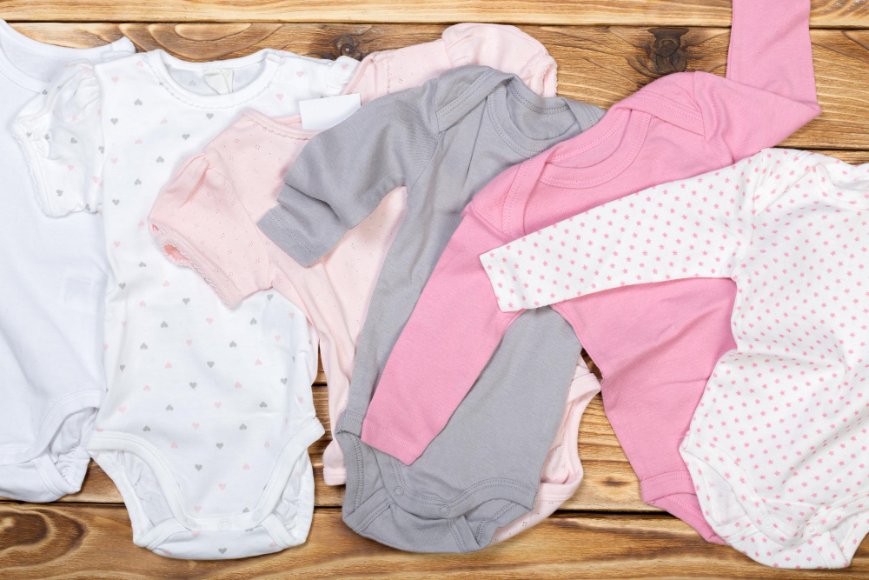
Planning your baby’s wardrobe for the entire first year requires thinking ahead about growth spurts and seasonal changes. Here’s a comprehensive breakdown:
How Many Clothes Does a Newborn Need?
For the first few weeks, you’ll need enough clothes to account for frequent changes due to spit-up, diaper leaks, and general messiness:
- 6-8 bodysuits/onesies (mix of short and long sleeve)
- 4-6 sleepers or pajamas
- 4-5 pants or leggings
- 2-3 swaddles or sleep sacks
- 6-8 pairs of socks
- 2-3 hats (one for warmth, one for sun)
- 3-4 bibs
How Early Should I Start Buying Baby Clothes?
Most experts recommend starting to buy baby clothes around 20-24 weeks of pregnancy. This gives you time to wash everything before baby arrives and take advantage of sales. Start with basics in newborn and 0-3 month sizes, then add seasonal items as you get closer to your due date.
How Many Outfits Does a Newborn Need at the Hospital?
For your hospital stay, pack 2-3 complete outfits in both newborn and 0-3 month sizes. Include:
- Going-home outfit in both sizes
- 1-2 backup outfits
- Extra onesies and sleepers
- Socks and hats
- Swaddle blankets
What Do Babies Wear Right After Birth?
Immediately after birth, babies typically wear a simple onesie or hospital gown, a hat to help regulate body temperature, and are swaddled in blankets. Skin-to-skin contact is prioritized in those first hours, so clothing is kept minimal.
What Size Do Babies Wear the Longest?
Most babies wear 3-6 month sizes the longest, typically for 2-3 months. This is because growth rate slows slightly after the initial rapid newborn growth, and this size range accommodates the most developmental changes.
Clothing Materials and Baby’s Comfort
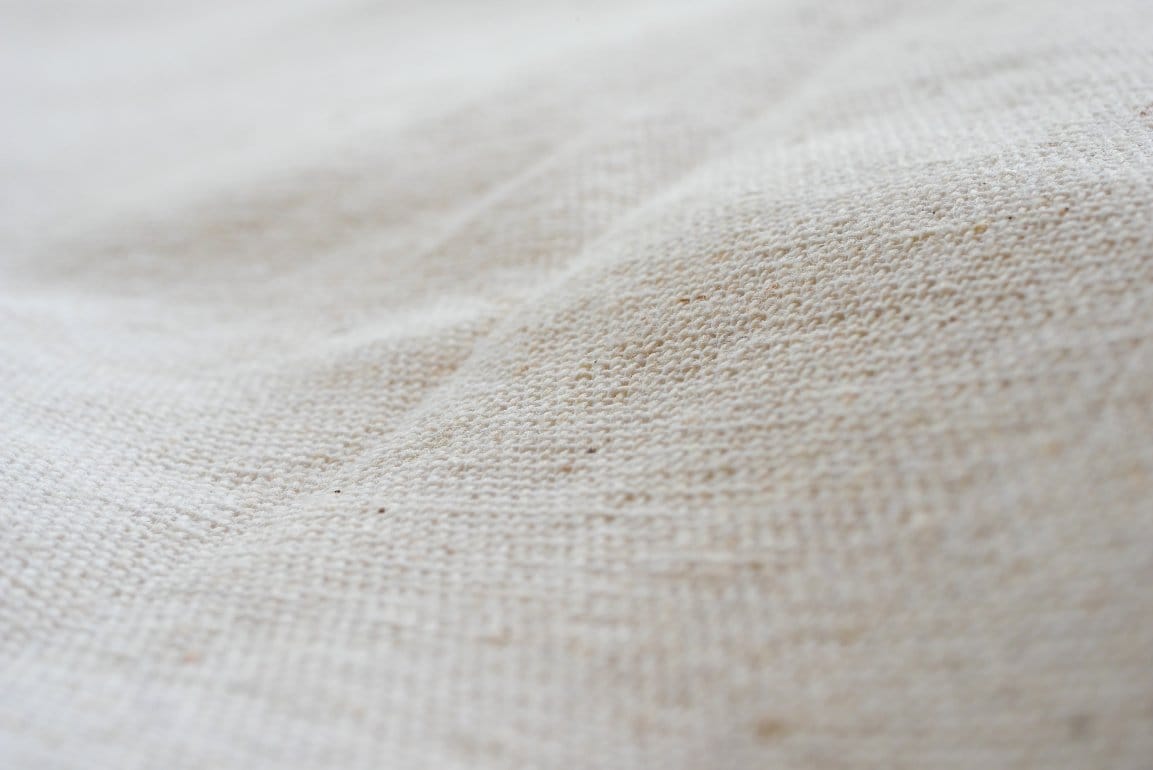
Babies need clothing made from safe, gentle materials that won’t irritate their sensitive skin. The right fabric choices help regulate body temperature and prevent skin reactions.
Organic Cotton & Natural Fabrics
Soft, breathable fabrics are essential for a baby’s delicate skin. Organic cotton stands out as the top choice for infant clothing because it contains no harsh chemicals or pesticides.
Natural fabrics allow proper airflow and help maintain stable body temperature. Cotton also becomes softer with each wash while maintaining its durability. Bamboo and Tencel offer excellent alternatives to cotton. These materials provide natural moisture-wicking properties and help prevent overheating during sleep or active periods.
Hypoallergenic Options
Babies have more sensitive skin than adults, making them prone to reactions from certain materials. Hypoallergenic fabrics prevent rashes and skin irritation.
You should avoid synthetic materials like polyester, which can trigger allergic responses. Look for clothing labeled specifically as hypoallergenic or made for sensitive skin. Natural fibers treated with non-toxic dyes provide the safest option for babies with skin sensitivities.
Best Fabrics for Babies
- Organic cotton
- Bamboo
- Tencel/Modal
- Merino wool (for outer layers)
- Hemp
Fabrics to Avoid
- Synthetic polyester
- Acrylic
- Fabrics with chemical treatments
- Rough or scratchy textures
- Non-breathable materials
Sustainable & Organic Baby Clothing Trends 2025 TRENDING
The sustainable baby clothing market is experiencing unprecedented growth as conscious parents prioritize environmental responsibility and baby safety. The global organic baby clothing market is expected to reach significant growth milestones by 2032.
Why Organic Matters More Than Ever
Conventional cotton uses 25% of the world’s pesticides, making organic alternatives crucial for both baby health and environmental protection. Organic fabrics are grown without harmful chemicals, reducing your baby’s exposure to toxins while supporting sustainable farming practices.
Key Certifications to Look For
- GOTS (Global Organic Textile Standard): The gold standard for organic textiles
- OEKO-TEX Standard 100: Ensures fabrics are free from harmful substances
- Organic Content Standard (OCS): Verifies organic material content
- Cradle to Cradle Certified: Comprehensive sustainability assessment
2025 Sustainable Trends
This year brings exciting developments in eco-friendly baby fashion:
- Circular clothing models: Brands offering clothing rental and buy-back programs
- Zero-waste design: Garments created with minimal fabric waste
- Plant-based dyes: Colors derived from natural sources like fruits and vegetables
- Biodegradable fibers: Materials that safely return to earth after use
- Multi-functional designs: Clothing that grows with your baby
Top Sustainable Brands for 2025
Leading organic baby clothing brands include Burt’s Bees Baby, Primary, Kate Quinn Organics, Hanna Andersson, and emerging sustainable brands focusing on circular economy models. Quality sustainable options are becoming more accessible to all budgets.
Styling Newborns: Tips and Trends
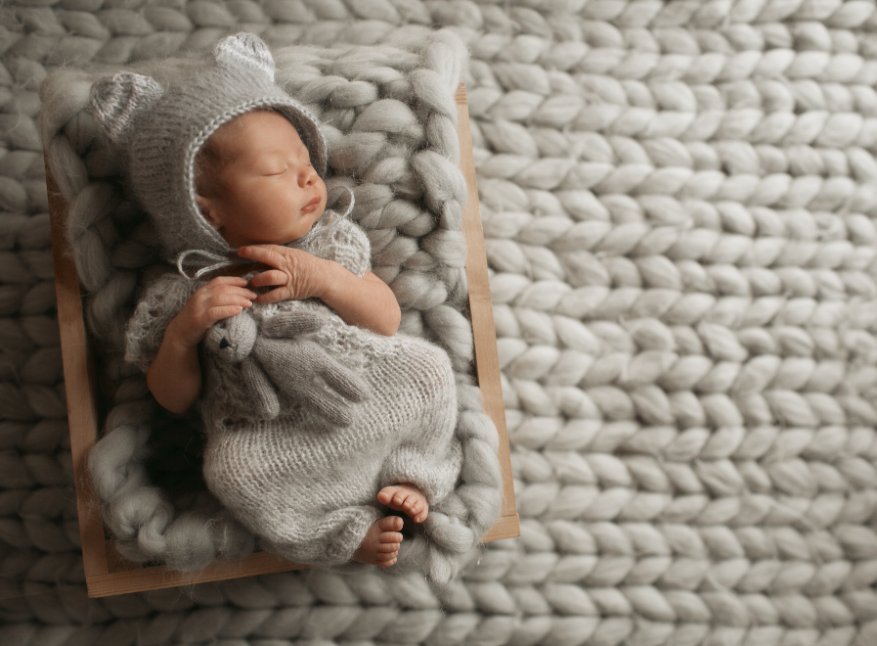
You can dress your little ones in fashionable outfits while keeping comfort as the top priority. Modern baby fashion trends focus on soft fabrics and practical designs that make dressing easy.
Seasonal Trends for 2025
Gender-neutral clothing options are gaining popularity in 2024-2025. Organic materials lead the way in baby fashion due to their gentle touch on sensitive skin.
Rompers and onesies with snap closures remain essential pieces for everyday wear. These items make diaper changes quick and simple. Spring and summer call for lightweight cotton dresses with built-in sun protection. Winter styles feature cozy layered pieces that keep babies warm without overheating.
Color Selections for Baby Attire
White remains a classic choice for newborns, offering a clean and timeless look. Many parents choose white as their base color for easy mixing and matching.
Earth tones and soft pastels create gentle, calming combinations. Playful prints and patterns add personality to baby outfits. Animal motifs and floral designs work well for both everyday wear and special occasions.
Trending Color Combinations for 2025:
- Sage green with cream
- Terracotta with soft beige
- Lavender with white
- Dusty pink with gray
- Warm camel with ivory
Safety and Practicality in Infant Wear
Safety standards for baby clothing are essential to protect infants from harm. You need to check that all clothing items are free from harmful chemicals and choking hazards.
CPSC Safety Requirements
According to the Consumer Product Safety Commission, children’s clothing must comply with several key safety standards:
- Flammability standards: All children’s sleepwear must meet strict flame-resistance requirements
- Lead content limits: Paint and surface coatings on children’s products cannot exceed 90 ppm lead
- Small parts regulations: Buttons, snaps, and decorative elements must be securely attached
- Drawstring restrictions: Drawstrings on children’s clothing pose strangulation hazards and are heavily regulated
AAP Safety Guidelines
The American Academy of Pediatrics provides specific recommendations for infant clothing safety:
- Avoid loose buttons, snaps, or decorative elements that could detach
- Choose clothing with flat seams to prevent chafing
- Ensure all fasteners are secure and baby-safe
- Remove hats indoors to prevent overheating
- Select snug-fitting sleepwear or flame-resistant options
Safety Checklist for Baby Clothes:
- No loose buttons or small parts that could be choking hazards
- Flat, smooth seams that won’t irritate skin
- Secure elastic bands that won’t restrict circulation
- No drawstrings or cords that could cause strangulation
- Flame-resistant sleepwear when required
- Easy access for diaper changes
- Breathable, non-toxic materials
Practical Considerations
Easy clothing changes are vital for both parents and babies. Select items with wide neck openings and snap closures along the legs and torso. This makes diaper changes smoother and less stressful.
- Size: Choose slightly larger sizes to allow growth
- Access: Front-opening designs for easy dressing
- Care: Machine-washable fabrics
- Temperature: Layer-friendly options for comfort
What Should a Baby Wear to Sleep
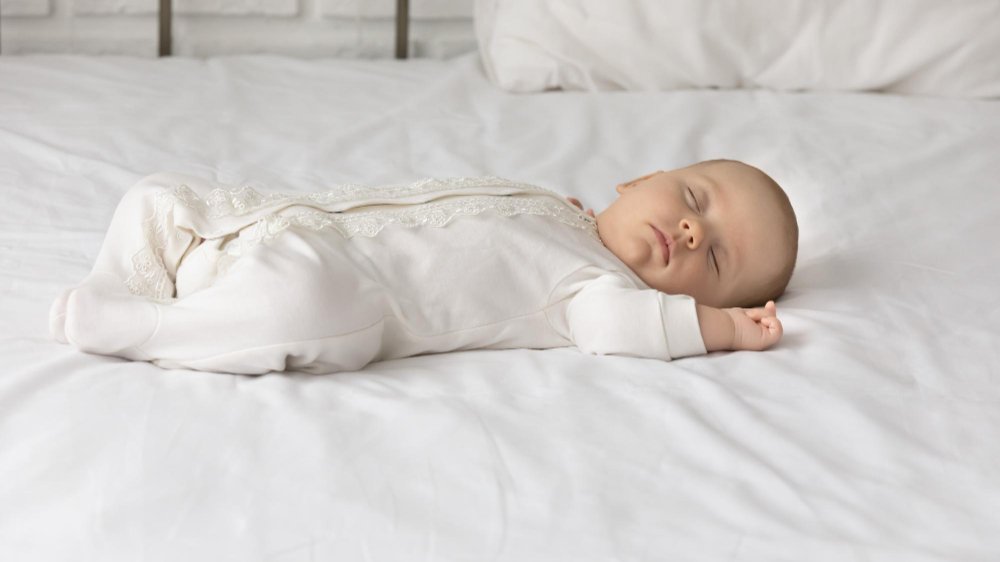
Safe sleep clothing is crucial for reducing the risk of SIDS (Sudden Infant Death Syndrome) and ensuring your baby stays comfortable throughout the night. The NHS and American Academy of Pediatrics provide clear guidelines on appropriate sleep attire.
Safe Sleep Clothing Guidelines
According to the American Academy of Pediatrics, you should dress your baby in layers of clothing rather than using loose blankets. This reduces the risk of head covering or entrapment that could result from blanket use.
Sleep Clothing Options by Season
Your baby’s sleep clothing should vary based on room temperature and season:
| Room Temperature | Recommended Clothing | Sleep Bag Tog |
|---|---|---|
| 16-20°C (61-68°F) | Long-sleeve bodysuit + sleep bag | 2.5 tog |
| 20-24°C (68-75°F) | Short-sleeve bodysuit + sleep bag | 1.0 tog |
| 24°C+ (75°F+) | Diaper + light sleep bag or just bodysuit | 0.5 tog |
How Many Newborn Pajamas Do I Need?
You’ll need 4-6 pairs of newborn pajamas or sleepers. This accounts for frequent changes due to diaper leaks, spit-up, and regular washing. Having extras ensures you’re never caught short during those inevitable middle-of-the-night changes.
How Many Sleepsuits Does a Newborn Need?
Plan for 6-8 sleepsuits in newborn size and another 6-8 in 0-3 month size. Sleepsuits are often the most-used item in a newborn’s wardrobe since they’re worn for sleep and often during the day in early weeks.
Do Newborns Need Socks?
Yes, newborns need socks to help regulate their body temperature. Babies lose heat through their extremities, so keeping feet covered is important. You’ll need 6-8 pairs of soft, stretchy socks that won’t leave marks on their legs.
When to Introduce a Duvet to a Toddler
The NHS recommends waiting until your child is at least 12 months old before introducing a duvet. Even then, choose a lightweight duvet with a low tog rating (4 tog maximum for toddlers). Sleep bags remain the safest option well into the toddler years.
Dressing Baby for Special Occasions
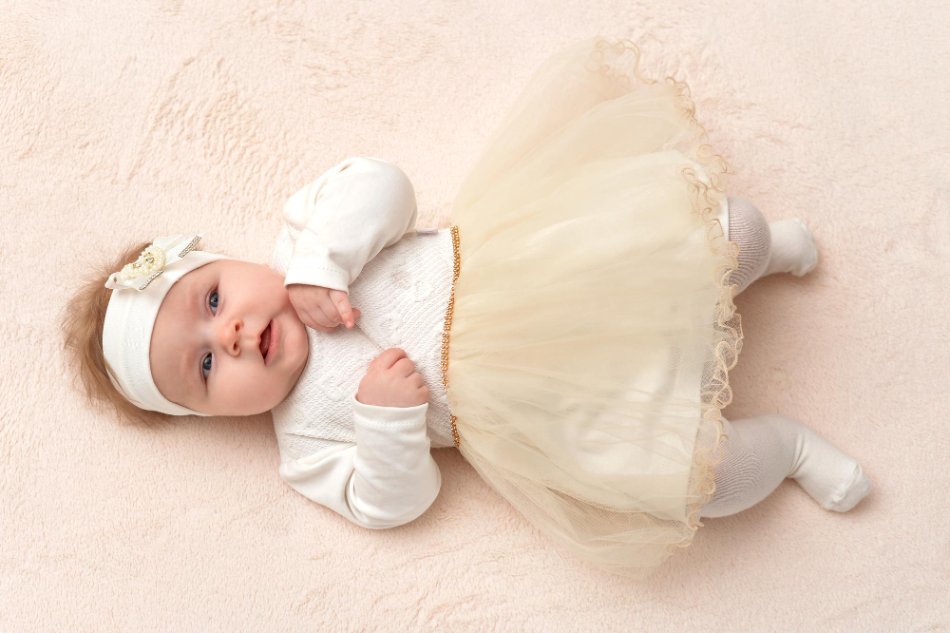
Special occasion outfits for babies require careful consideration of comfort, style, and practicality while making sure they look picture-perfect for memorable moments.
Holiday-Themed Outfits
Silky dresses and shiny fabrics make excellent choices for baby girls during holiday celebrations. The material reflects light beautifully while keeping little ones comfortable.
For Halloween, soft cotton costumes with snap closures work best for easy diaper changes. Avoid outfits with small decorative pieces that could pose safety risks. Christmas calls for festive wear like velvet dresses or tiny suits. Red and green plaids, sparkly accessories, and comfortable holiday-themed sleepwear are popular choices.
Formal Attire for Infants
Special occasion dresses for baby girls often feature delicate details like ribbons and lace. You should choose breathable fabrics and avoid scratchy materials that might irritate sensitive skin.
Baby boys look dapper in miniature suits or dress shirt and pant combinations. Clip-on bowties offer a formal touch without the hassle of traditional ties.
For religious ceremonies like baptisms, traditional white outfits remain a classic choice. These ensembles often come with matching accessories like bonnets or caps.
Special Occasion Essentials:
- Comfortable formal wear in soft fabrics
- Easy-access designs for diaper changes
- Weather-appropriate outer layers
- Backup outfit in case of accidents
- Comfortable shoes (if walking)
Consider purchasing formal wear slightly larger to accommodate growth, but not so large that it becomes a safety concern.
Shopping for Baby Clothes on a Budget
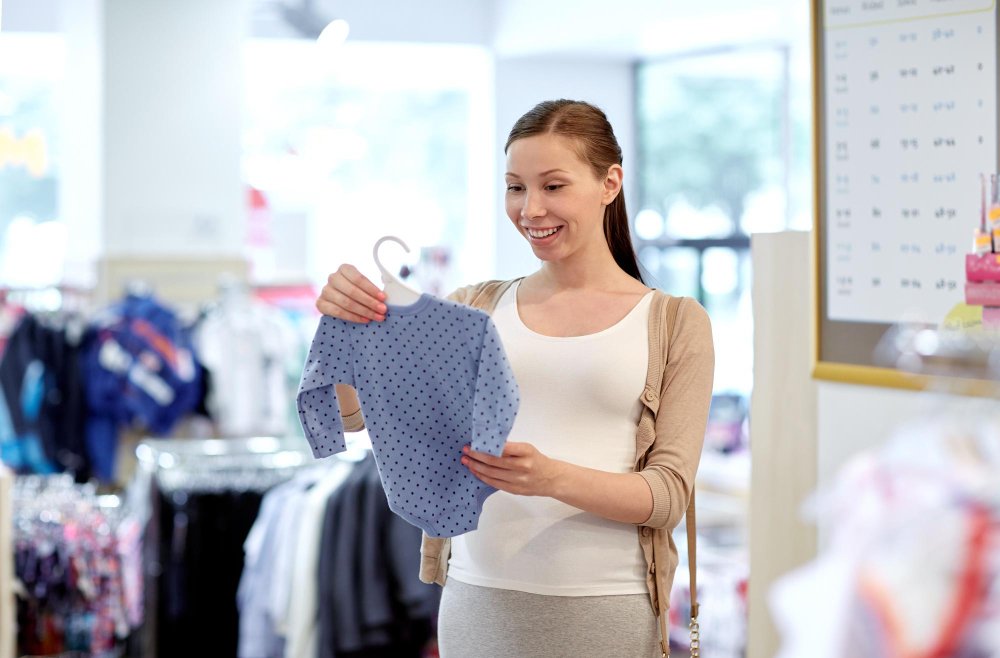
You can find quality baby clothes without spending too much money. Many popular retailers offer frequent sales and discounts throughout the year.
Major stores like Amazon, Target, and Old Navy provide budget-friendly baby clothing options. These retailers often run promotions with significant savings on essential items like onesies, sleepwear, and everyday outfits.
Clearance sections are excellent places to find discounted baby clothes. You can save up to 70% off original prices on high-quality items from trusted brands.
Money-Saving Tips for Baby Clothes:
- Buy basics in multi-packs
- Shop end-of-season sales
- Sign up for store newsletters to get discount codes
- Check outlet stores
- Look for bundle deals
- Consider secondhand options from trusted sources
- Join parent Facebook groups for clothing swaps
Online boutiques often provide stylish baby clothes at reasonable prices. These shops frequently offer special deals and seasonal promotions on their collections.
Buying clothing a size larger allows babies to wear items longer as they grow. This strategy helps you get more value from your purchases. Stock up on essential items like cotton onesies and bodysuits when they go on sale. These versatile pieces form the foundation of any baby’s wardrobe.
Best Times to Shop for Baby Clothes
- End-of-season clearances: Buy next year’s clothes at 50-70% off
- Black Friday and Cyber Monday: Major retailers offer significant discounts
- Back-to-school season: Children’s clothing goes on sale
- Post-holiday sales: Great for special occasion wear
Gift-Giving Guide for Newborn Clothing
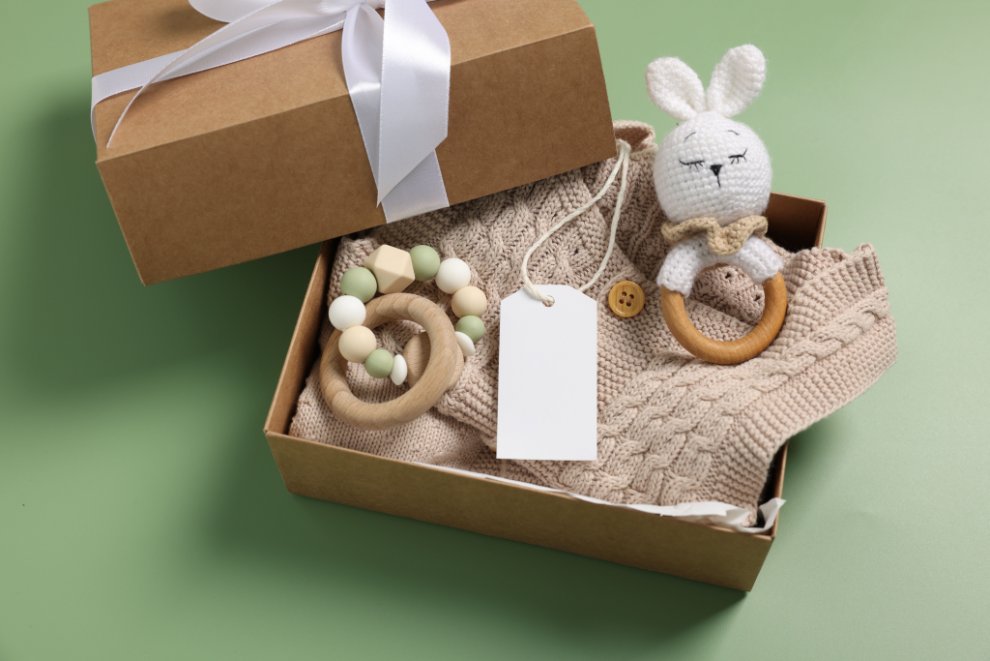
Picking the right size is key when buying baby clothes as gifts. Many babies skip the newborn size completely or only wear it for a week or two.
The best sizes to choose for gifts are 3-6 months or 6-9 months. This gives parents time to use the clothing when they need it most, after the initial newborn period.
Consider the season when the baby will wear the clothes. A 6-month size given to a winter newborn should be suitable for summer weather, since the baby will grow into it by then.
Smart Gift-Giving Sizes by Season:
- Winter babies: Buy 6-12 month summer clothes
- Spring babies: Buy 9-12 month fall/winter clothes
- Summer babies: Buy 6-9 month fall clothes
- Fall babies: Buy 6-9 month spring/summer clothes
Parents often get lots of tiny outfits but need more practical clothing in larger sizes. Basic items like onesies, sleepers, and stretchy pants make great gifts. Gift cards and registry items are smart choices. These let parents pick exactly what they need in the right sizes and seasons.
Tips for Clothing Gifts:
- Check growth patterns with parents
- Include gift receipts
- Pick easy-care fabrics
- Choose simple designs
- Buy practical basics
- Consider organic or sustainable options
Parents appreciate when gift-givers ask about the baby’s size and growth. This helps ensure the clothes will fit when needed.
Baby Clothing Care and Maintenance
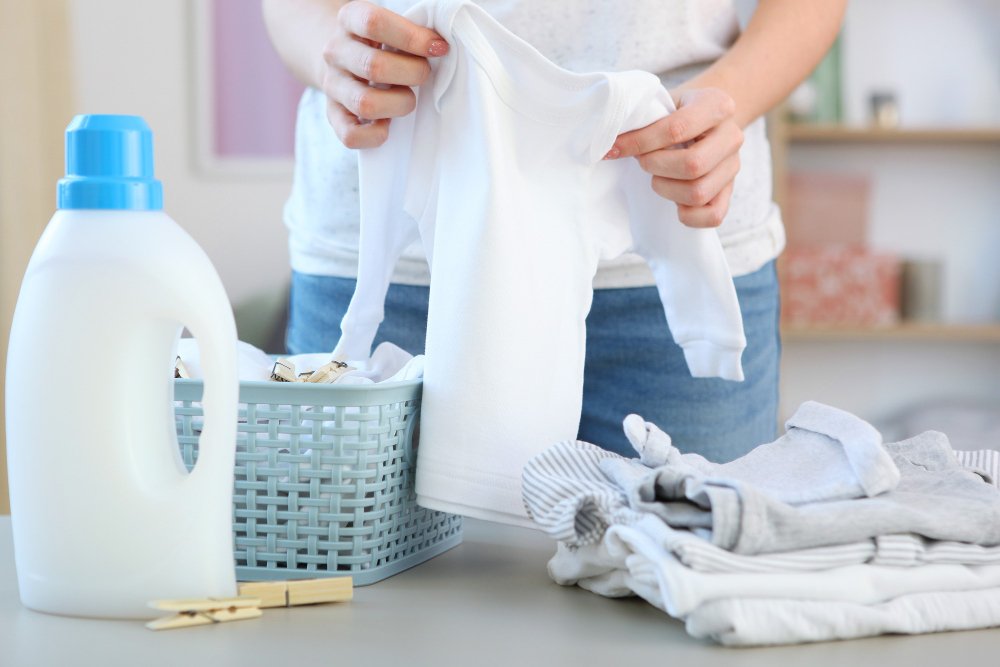
Proper care helps baby clothes last longer and keeps them safe for sensitive infant skin. Using a gentle baby-safe detergent is essential for washing infant clothing.
Separate baby clothes from heavy items like towels and jeans during washing. Heavy fabrics can damage delicate baby garments through friction and cause tears.
White vinegar works well for removing stains from formula, food, and diaper messes. Add one cup to the wash cycle with regular detergent.
Essential Care Guidelines
Cotton baby clothes are easy to maintain and can handle frequent washing. Pre-treat stains right away to prevent them from setting. Use cool or warm water for washing – hot water can shrink garments and fade colors.
Key Care Tips:
- Wash new clothes before first use
- Turn garments inside out
- Zip zippers and fasten buttons
- Air dry when possible
- Check care labels
- Store in clean, dry places
- Use hypoallergenic detergents
Stain Removal for Common Baby Messes
- Formula/milk: Rinse with cold water immediately, then wash
- Baby food: Scrape off excess, pre-treat with enzyme detergent
- Diaper leaks: Rinse in cold water, use oxygen bleach if needed
- Spit-up: Blot (don’t rub), rinse with cold water
Organizing clothes by size using labeled hangers or drawer dividers makes it easy to find the right outfit quickly. This helps prevent damage from stuffing or stretching clothes.
Storage Tips for Outgrown Clothes
If you’re planning to save clothes for future children or to pass along to others:
- Clean thoroughly before storing
- Use breathable storage containers
- Add lavender sachets to deter insects
- Label containers by size and season
- Check stored items annually
Frequently Asked Questions
Size 6-12 months typically fits babies weighing 16-22 pounds and measuring 26-29 inches long. This size usually fits babies from about 6 months to their first birthday, though growth rates vary significantly.
You’ll need 6-8 muslin cloths for a newborn. These versatile items are used for burping, cleaning up spills, light swaddling, and as emergency bibs. Having extras ensures you always have clean ones available.
Medically, the newborn period ends at 28 days (4 weeks). After this, babies are considered infants. However, in clothing terms, “newborn” sizes are typically worn until 2-8 weeks, depending on the baby’s growth rate.
Size 0000 is designed for very small babies, typically premature infants or those under 5 pounds. It’s equivalent to “Preemie” size in many brands and fits babies up to about 44cm (17 inches) long.
50cm (about 19.7 inches) is within the normal range for newborns, though slightly above average. Most full-term babies are born between 46-53cm long. A 50cm baby would likely fit into newborn or 0-3 month clothing depending on their weight.
Yes, 0-3 month sizes often fit newborns, especially larger babies over 8 pounds. Many parents find 0-3 month sizes more practical than newborn sizes because babies grow into them quickly and wear them longer.
Pack 4-7 onesies and 4-5 footed sleepers for the hospital stay. Choose front-opening options for easier dressing and diaper changes. Select clothes with loose necklines and snap closures to avoid pulling garments over the baby’s head. Make sure all items are pre-washed in gentle detergent to protect your baby’s sensitive skin.
Cotton is ideal for newborn clothing due to its softness and breathability. Organic cotton reduces exposure to chemicals. Avoid fabrics with rough seams or decorative elements that might irritate the skin. Choose stretchy materials like cotton jersey for easy dressing and movement.
Dress babies in light layers during summer, including a onesie and thin cotton pants. Keep a light blanket handy for air-conditioned spaces. Winter requires more layers – start with a onesie, add warm pants, and top with a cozy sleeper. Add or remove layers based on room temperature and baby’s comfort level.
Remove all tags and wash new clothes before use to eliminate potential irritants. Check for secure buttons and snaps. Avoid clothing with drawstrings or loose decorations that could pose choking hazards. Choose flame-resistant sleepwear for safety during overnight sleep.
Conclusion
Building the perfect newborn wardrobe doesn’t have to be overwhelming. By focusing on comfort, safety, and practicality, you can create a functional and stylish collection that serves your baby well throughout their first year.
Essential Recommendations:
- Prioritize organic and sustainable options when possible – they’re gentler on baby’s skin and better for the environment
- Invest in quality basics like bodysuits, sleepers, and simple pants that can be mixed and matched
- Don’t overbuy newborn sizes – focus on 0-3 and 3-6 month sizes for better value
- Choose safety over style – avoid drawstrings, loose buttons, and non-flame-resistant sleepwear
- Layer for temperature control rather than using heavy single pieces
Future-Proof Your Investment:
Remember that babies grow rapidly and their needs change constantly. Plan for hand-me-downs and reusability by choosing timeless designs in quality fabrics. The sustainable fashion movement isn’t just a trend – it represents a fundamental shift toward more responsible consumption that benefits both your family and future generations.
Your Baby’s Comfort Comes First:
While it’s tempting to dress your little one in the most adorable outfits, always remember that comfort and safety are paramount. A happy, comfortable baby is far more important than the perfect photo opportunity. Choose clothes that make your life easier – snap closures over buttons, stretchy fabrics over stiff ones, and simple designs over complicated ensembles.
As you embark on this exciting journey of parenthood, remember that every baby is unique. What works for one family may not work for another, and that’s perfectly okay. Trust your instincts, prioritize your baby’s needs, and don’t hesitate to adjust your approach as you learn what works best for your little one.
Most importantly, enjoy this special time. Those tiny clothes won’t fit for long, but the memories of dressing your baby in their first outfits will last a lifetime. Welcome to the wonderful world of parenthood!


